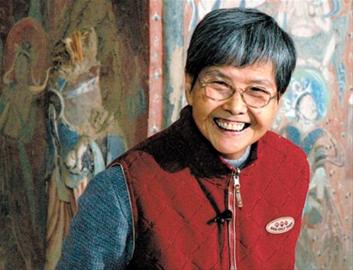'Daughter of Dunhuang:' Fan Jinshi
 |
|
Fan Jinshi |
Fan Jinshi, president of the Dunhuang Academy, is more widely known as the "daughter of Dunhuang." She has spent more than four decades studying the preservation of the 1,600-year-old Dunhuang Mogao Grottoes.
The Dunhuang Mogao Grottoes were built from the 4th century to the 14th century by monks as sites for worship and meditation. The site boasts at least 490 cave temples carved into a cliff 24 km outside Dunhuang City in northwest China. The temples are covered with elaborate Buddhist murals portraying visions of heaven and earth. Statues also litter the caves, including a 34.5-meter-tall Buddha that towers above visitors in one cave.
Battered by natural erosion and man-made destruction, the temples have become increasingly vulnerable in recent years. Their preservation poses a big challenge for Fan.
Together with other scholars from the Dunhuang Academy, Fan has made several breakthroughs in grotto preservation technologies such as the protection of murals, the consolidation of cliffs and the reduction of sandstorms' impact on the temples.
Fan also works hard to promote cooperation between the Dunhuang Academy and overseas archaeological institutions such as the U.S.'s Getty Conservation Institution.
Thanks to her efforts, conservators have utilized state-of-the-art technology to preserve the grottoes, and the surrounding environment has improved significantly. The academy has a group of outstanding scholars who have the technical know-how to deal with relics.
In 1979, the Mogao Grottoes opened to the public, attracting thousands of visitors from China and abroad. But while the grottoes shot to fame, the narrow temples and fragile murals began to crumble.
By the end of 2008, Fan proposed improvements to the Chinese People's Political Consultative Conference (CPPCC), China's top political advisory body, and a program was launched to better preserve and display the cultural relics. It is the largest preservation program in Dunhuang's history.
The program includes the establishment of a digital database. The 149 most spectacular grottoes will be photographed and added to the database, offering tourists a new way to explore the caves.
In the past, the best Dunhuang scholars were based overseas. Now the situation has changed. Under Fan's leadership, the Dunhuang Academy has grown into the world's largest institution for Dunhuang studies, making many achievements in archeological excavation and the study of Buddhist art. "The longer I've stayed here, the deeper my love has grown for Dunhuang," Fan said.
 0
0 







Go to Forum >>0 Comments